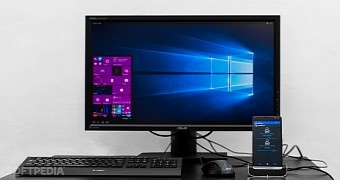Microsoft announced Continuum with much fanfare in late 2015, as the company was trying to turn Windows phones into super-portable PCs that could allow users to stay productive using just a mouse, a keyboard, and an external screen.
Continuum has received several improvements since then, and Microsoft is set to deliver even more updates in the future, including support for resizable windows, a PC-like taskbar, and even a system tray that would make the whole experience more similar to the one on the desktop.
And while Microsoft has pushed so hard for Continuum, other companies have always been quite reluctant to offer a feature that would turn smartphones into PCs using a bunch of accessories. But now giving the direction that Continuum is heading to, more smartphone manufacturers seem to be interested in implementing similar technologies in their devices. And Samsung is one of them.
It appears that one of the features coming on the upcoming Galaxy S8 flagship is very similar to Windows 10 Mobile’s Continuum, as the South Korean firm is aiming at offering users an easy way to convert the device into a computer with a bigger screen.
DeX and Continuum
Samsung’s so-called DeX feature (which stands for Desktop Experience) will allow buyers of the Galaxy S8 to connect the phone to an external screen to get access to new functionality, such as multi-tasking. When connected to the bigger screen, the Android UI will scale to look correctly in a similar way with Windows 10 Mobile when switching to Continuum.
The interface adapts to the dimensions of the display, so everything will look correctly on Android as well. Most apps can already be used with a mouse and keyboard, and given the fact there are already 2-in-1 devices running Android, the S8 could end up tackling more than just the smartphone world.
To make the connection to an external screen possible, Samsung will turn to a dock, as is the case with Microsoft’s Windows 10 Mobile, so users will have a series of ports, including USB for connecting mice and keyboards. Most likely, when plugged into the dock, the S8 will also recharge, so Samsung will kill two birds with one stone.
It goes without saying that Samsung’s new feature looks, works, and feels a lot like Microsoft’s Continuum, with the only big difference that the S8 runs Android, while Microsoft’s implementation is based on Windows 10 Mobile.
The Galaxy S8 is projected to debut later this spring (definitely not at the Mobile Word Congress next month), so we’ll learn more about the DeX in just a few months.

 14 DAY TRIAL //
14 DAY TRIAL //